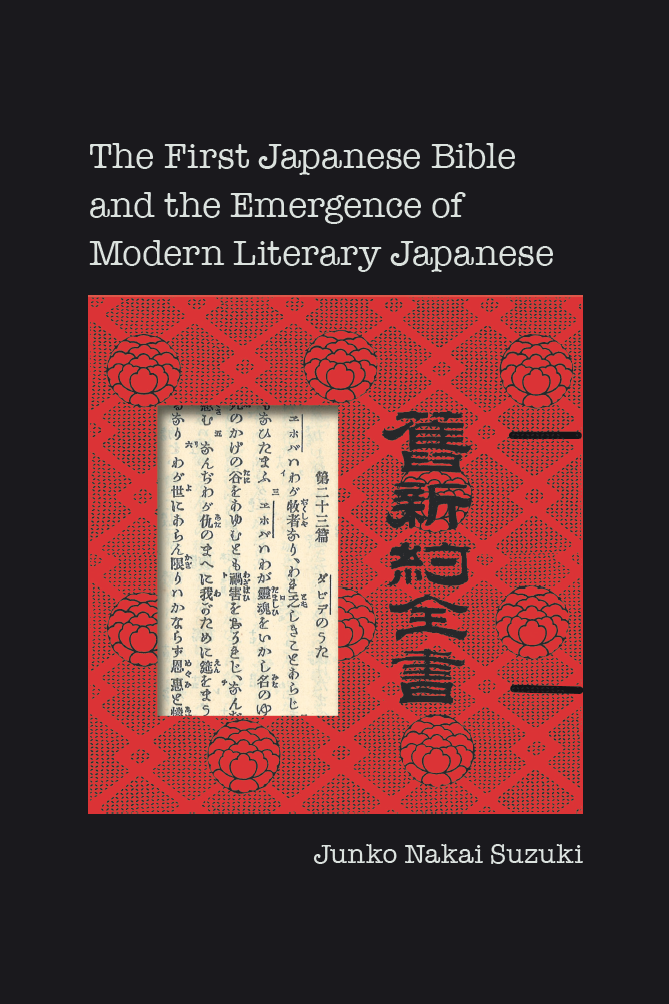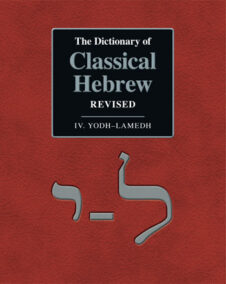Sale
The Dictionary of Classical Hebrew Revised. IV. Yodh–Lamedh.
Published: Nov 2025
Original price was: £150.00.£75.00Current price is: £75.00.
The Dictionary of Classical Hebrew Revised (DCHR) (2018–2028) is a complete revision in nine volumes, with over 100,000 improvements, of the original Dictionary of Classical Hebrew (DCH) (1993–2016). When completed, DCHR will be 5 million words in length (equivalent to 50 standard-size books), 25% longer than DCH, and 4 times the length of BDB and HALOT.
The fourth Volume of The Dictionary of Classical Hebrew Revised, Yodh–Lamedh, arrives 27 years after the publication of the corresponding volume in the first edition (DCH) in 1998.
The Dictionary of Classical Hebrew Revised, when completed, will contain more than 6,420 Hebrew words not in BDB, and will refer to many newly published texts, including 540 Dead Sea Scrolls and 4,000 ancient Hebrew inscriptions. New features in DCHR include: a notation of 4,285 byforms (words with the same meaning and similar form) identified for the first time; 717 verbal nouns (nouns derived from a verb) with their own articles (not previously shown in Hebrew lexica), 345 denominative verbs (verbs derived from a noun), and the semantic field to which every word belongs (a totally new feature for Hebrew dictionaries).
Data on synonyms have been greatly expanded, and loanwords from other languages included. Articles on personal names show (for the first time) all short forms, long forms, and alternative forms of each name, the Bibliography has been updated and expanded, and 35,000 emendations of biblical texts noted.
Every occurrence of each word in Classical Hebrew is noted. All the subjects and objects of verbs are listed, and the verbs used with each noun, as well as all nouns used in a construct (genitive) relation with another noun. As with DCH, every Hebrew word in the revised Dictionary (except for the variant forms of a word, the byforms and the sections on synonyms) is followed immediately by an English translation, so that the Dictionary can be easily understood by a person with little or no Hebrew.
Among the resources that have been reviewed for the present volume are:
-philological studies on Hebrew words, such as Aitken on blessing and cursing, Koller on tools, and Peters on cooking;
-handbooks on loanwords from other languages, such as Noonan on non-Semitic words, Mankowski on Akkadian and Muchiki on Egyptian loanwords;
-treatments of realia such as Borowski on agriculture and animals, Musselman on plants and Wiggins on weather;
-collections of inscriptions such as the second volume of Davies on Hebrew inscriptions, Lifschits and Vanderhooft on Yehud stamp impressions and Deutsch on Hebrew bullae and biblical period epigraphy.
There is a special discount price for customers subscribing to the DCHR set, and an easy payment plan (details from phoenix.bibs@sheffield.ac.uk).
Sale
The Dictionary of Classical Hebrew Revised. IV. Yodh–Lamedh.
Original price was: £150.00.£75.00Current price is: £75.00.
The Dictionary of Classical Hebrew Revised (DCHR) (2018–2028) is a complete revision in nine volumes, with over 100,000 improvements, of the original Dictionary of Classical Hebrew (DCH) (1993–2016). When completed, DCHR will be 5 million words in length (equivalent to 50 standard-size books), 25% longer than DCH, and 4 times the length of BDB and HALOT.
The fourth Volume of The Dictionary of Classical Hebrew Revised, Yodh–Lamedh, arrives 27 years after the publication of the corresponding volume in the first edition (DCH) in 1998.
The Dictionary of Classical Hebrew Revised, when completed, will contain more than 6,420 Hebrew words not in BDB, and will refer to many newly published texts, including 540 Dead Sea Scrolls and 4,000 ancient Hebrew inscriptions. New features in DCHR include: a notation of 4,285 byforms (words with the same meaning and similar form) identified for the first time; 717 verbal nouns (nouns derived from a verb) with their own articles (not previously shown in Hebrew lexica), 345 denominative verbs (verbs derived from a noun), and the semantic field to which every word belongs (a totally new feature for Hebrew dictionaries).
Data on synonyms have been greatly expanded, and loanwords from other languages included. Articles on personal names show (for the first time) all short forms, long forms, and alternative forms of each name, the Bibliography has been updated and expanded, and 35,000 emendations of biblical texts noted.
Every occurrence of each word in Classical Hebrew is noted. All the subjects and objects of verbs are listed, and the verbs used with each noun, as well as all nouns used in a construct (genitive) relation with another noun. As with DCH, every Hebrew word in the revised Dictionary (except for the variant forms of a word, the byforms and the sections on synonyms) is followed immediately by an English translation, so that the Dictionary can be easily understood by a person with little or no Hebrew.
Among the resources that have been reviewed for the present volume are:
-philological studies on Hebrew words, such as Aitken on blessing and cursing, Koller on tools, and Peters on cooking;
-handbooks on loanwords from other languages, such as Noonan on non-Semitic words, Mankowski on Akkadian and Muchiki on Egyptian loanwords;
-treatments of realia such as Borowski on agriculture and animals, Musselman on plants and Wiggins on weather;
-collections of inscriptions such as the second volume of Davies on Hebrew inscriptions, Lifschits and Vanderhooft on Yehud stamp impressions and Deutsch on Hebrew bullae and biblical period epigraphy.
There is a special discount price for customers subscribing to the DCHR set, and an easy payment plan (details from phoenix.bibs@sheffield.ac.uk).
Sale
The First Japanese Bible, and its Role in the Emergence of Modern Literary Japanese
Published: Sep 2025
Original price was: £85.00.£36.00Current price is: £36.00.
This ground-breaking book depicts the life, times and works of the Bible translators of nineteenth-century Japan and the prominent role they played in helping to shape modern Japan.
The translation of the Bible into Japanese occurred at a time of great cultural turmoil, when Japan was grappling with industrial and technological modernization in the shift from a feudal agrarian society after 260 years of isolation. In this turmoil, the cultural question of literary style was deemed of great importance. Because of the dichotomy between those who read Chinese (in a Japanese way) and those who did not, the need for reform and simplification was considered an essential aspect of the modernization of Japanese society. The Japanese Bible emerged as a prime example of such a style.
Suzuki’s study traces the development of the primary versions that culminated in the production of the first complete Japanese Bible, the Meiji Version of 1887. The translation of the Psalms, in particular, gained wide acclaim, even being said to be as incomparable as Mt Fuji. The literary quality of the Hebrew Bible was conveyed by the integration of a pure Japanese elegance, Chinese gravitas and freshness of Western and even some Hebrew elements of style.
For the first time, this volume gives due weight to three factors: appreciation of the Chinese Bible by the Japanese Bible translation, its fidelity to the primary Hebrew and Greek source texts, and its adoption of a pure Japanese style as the foundation.
Sale
The First Japanese Bible, and its Role in the Emergence of Modern Literary Japanese
Original price was: £85.00.£36.00Current price is: £36.00.
This ground-breaking book depicts the life, times and works of the Bible translators of nineteenth-century Japan and the prominent role they played in helping to shape modern Japan.
The translation of the Bible into Japanese occurred at a time of great cultural turmoil, when Japan was grappling with industrial and technological modernization in the shift from a feudal agrarian society after 260 years of isolation. In this turmoil, the cultural question of literary style was deemed of great importance. Because of the dichotomy between those who read Chinese (in a Japanese way) and those who did not, the need for reform and simplification was considered an essential aspect of the modernization of Japanese society. The Japanese Bible emerged as a prime example of such a style.
Suzuki’s study traces the development of the primary versions that culminated in the production of the first complete Japanese Bible, the Meiji Version of 1887. The translation of the Psalms, in particular, gained wide acclaim, even being said to be as incomparable as Mt Fuji. The literary quality of the Hebrew Bible was conveyed by the integration of a pure Japanese elegance, Chinese gravitas and freshness of Western and even some Hebrew elements of style.
For the first time, this volume gives due weight to three factors: appreciation of the Chinese Bible by the Japanese Bible translation, its fidelity to the primary Hebrew and Greek source texts, and its adoption of a pure Japanese style as the foundation.
Sale
Reading the Landscape of Ezekiel 40-48: A Theology of Resilience
Published: Sep 2025
Original price was: £75.00.£35.00Current price is: £35.00.
When the landscape architect IChun Kuo opens up an ancient plan written in the book of Ezekiel, she encounters a planner who is called “son of man”, who was instructed to a vision. Bewildered by this unworldly yet grounded visioned plan, Kuo seeks help from Assyrian King Sennacherib who constructed gardens, Jerome who was puzzled by the labyrinth, Newton who was obsessed with the measurement. She asks biblical scholars, archaeologists, architects and planners, until she finds the patterns.
Reading the Landscape of Ezekiel is a journey of decoding a mesmerizing ancient landscape, which reflects history of social and ecological catastrophes, survival and renovation, and the mechanisms of God’s design. Kuo argues that Ezekiel 40–48 can be understood as an ancient resilient landscape plan that encompasses rigidity and ductility, resistance and recovery.
Given the ancient hazards described in Ezekiel (sword, famine, evil creatures, and pestilence), the mechanism of landscape resilience in Ezekiel 40–48 is similar to modern time ecosystem resilience, as well as disaster risk reduction, and epidemiology/public health of war and defence policy. An understanding of the ancient planning in Ezekiel 40–48 may shed light on our reading of the biblical text, our way of viewing the depicted visions, as well as the implications of our planning of the environment.
Sale
Reading the Landscape of Ezekiel 40-48: A Theology of Resilience
Original price was: £75.00.£35.00Current price is: £35.00.
When the landscape architect IChun Kuo opens up an ancient plan written in the book of Ezekiel, she encounters a planner who is called “son of man”, who was instructed to a vision. Bewildered by this unworldly yet grounded visioned plan, Kuo seeks help from Assyrian King Sennacherib who constructed gardens, Jerome who was puzzled by the labyrinth, Newton who was obsessed with the measurement. She asks biblical scholars, archaeologists, architects and planners, until she finds the patterns.
Reading the Landscape of Ezekiel is a journey of decoding a mesmerizing ancient landscape, which reflects history of social and ecological catastrophes, survival and renovation, and the mechanisms of God’s design. Kuo argues that Ezekiel 40–48 can be understood as an ancient resilient landscape plan that encompasses rigidity and ductility, resistance and recovery.
Given the ancient hazards described in Ezekiel (sword, famine, evil creatures, and pestilence), the mechanism of landscape resilience in Ezekiel 40–48 is similar to modern time ecosystem resilience, as well as disaster risk reduction, and epidemiology/public health of war and defence policy. An understanding of the ancient planning in Ezekiel 40–48 may shed light on our reading of the biblical text, our way of viewing the depicted visions, as well as the implications of our planning of the environment.




